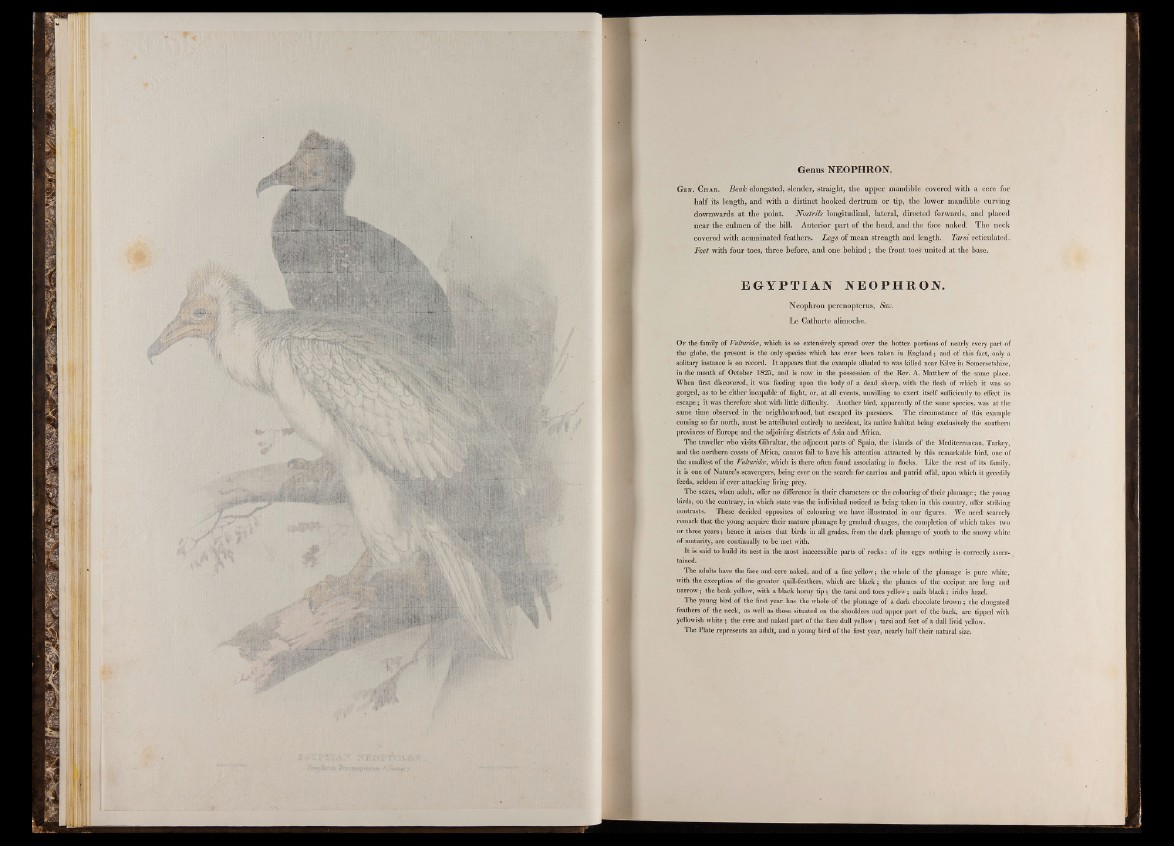
Genus NEOPHRON.
Gen. Char. Beak elongated, slender, straight, the upper mandible covered with a cere for
half its length, and with a distinct hooked dertrum or tip, the lower mandible curving
downwards at the point. Nostrils longitudinal, lateral, directed forwards, and placed
near the culmen of the bill. Anterior part of the head, and the face naked. The neck
covered with acuminated feathers. Legs of mean strength and length. Tarsi reticulated.
Feet with four toes, three before, and one behind; the front toes united at the base.
E G Y P T IA N NEOPHRON.
Neophron percnopterus, Sav.
Le Catharte alimoche.
Of the family of Vulturidce, which is so extensively spread over the hotter portions of nearly every part of
the globe, the present is the only species which has ever been taken in England; and of this fact, only a
solitary instance is on record. It appears that the example alluded to was killed near Kilve in Somersetshire,
in the month of October 1825, and is now in the possession of the Rev.' A. Matthew of the same place.
When first discovered, it was feeding upon the body of a dead sheep, with the flesh of which it was so
gorged, as to be either incapable of flight, or, at all events, unwilling to exert itself sufficiently to effect its
escape; it was therefore shot with little difficulty. Another bird, apparently of the same species, was at the
same time observed in the'neighbourhood, but escaped its pursuers. The circumstance of this example
coming so far north, must be attributed entirely to accident, its native habitat being exclusively the southern
provinces of Europe and the adjoining districts of Asia and Africa.
The traveller who visits Gibraltar, the adjacent parts of Spain, the islands of the Mediterranean, Turkey,
and the northern coasts of Africa, cannot fail to have his attention attracted by this remarkable bird, one of
the smallest of the Vulturidce, which is there often found associating in flocks. Like the rest of its family,
it is one of Nature’s scavengers, being ever on the search for carrion and putrid offal, upon which it greedily
feeds, seldom if ever attacking living prey.
The sexes, when adult, offer no difference in their characters or the colouring of their plumage; the young
birds, on the contrary, in which state was the individual noticed as being taken in this country, offer striking
contrasts. These decided opposites of colouring we have illustrated in our figures. We need scarcely
remark that the young acquire their mature plumage by gradual changes, the completion of which takes two
or three years; hence it arises that birds in all grades, from, the dark plumage of youth to the snowy white
of maturity, are continually to be met with.
It is said to build its nest in the most inaccessible parts of rocks: of its eggs nothing is correctly ascertained.
The adults have the face and cere naked, and of a fine yellow; the whole of the plumage is pure white,
with the exception of the greater quill-feathers, which are black; the plumes of the occiput are long, and
narrow; the beak yellow, with a black horny tip; the tarsi and toes yellow; nails black; irides hazel.
The young bird of the first year has the whole of the plumage of a dark chocolate brown; the elongated
feathers of the neck, as well as. those situated on the shoulders and upper part of the back, are tipped with
yellowish white; the cere and naked part of the face dull yellow; tarsi and feet of a dull livid yellow.
The Plate represents an adult, and a young bird of the first year, nearly half their natural size.